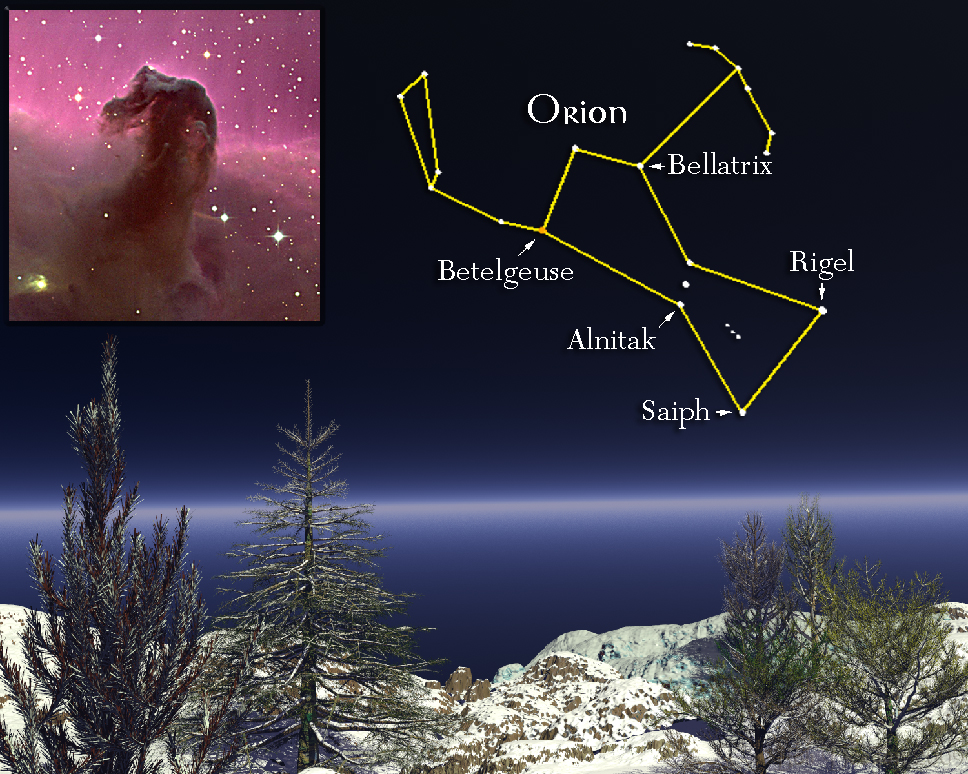
For the week including December 18, 2009

THE HUNTER
For many amateur stargazers there’s no richer area to explore than the constellation of Orion, the Hunter, the most recognizable collection of stars, other than those of the Big Dipper. Rising in the east after sunset, the constellation of Orion has an hourglass-shape that is marked by the bright stars Betelgeuse, Bellatrix, Rigel, and Saif and by a distinctive line of three bright stars.
The plainly red star Betelgeuse is the tenth brightest star visible to the naked eye. If you’re wondering how to pronounce that star’s name, forget it, it’s too complicated. Just remember that astronomers refer to it as “BEETLE-JUICE”. The name Betelgeuse itself is a corruption of the original Arabic, Ibt al Jauzah, meaning the “Armpit of the Giant” or, “The Giant Armpit”; it depends on where you place the emphasis. Betelgeuse is a red super-giant star sitting a little over three hundred light years away in space. It’s also one of the largest stars in our galaxy with an estimated volume large enough to hold 160,000,000 of our Suns. If Betelgeuse were our sun, its surface would extend past Jupiter! We say Betelgeuse has an estimated volume because it changes its size every now and then. At times it swells up and adds some 400,000,000 miles to its size. In spite of its enormity, Betelgeuse isn’t very massive; the air we breathe is about 500,000,000 times denser.
Bellatrix (Latin for “Female Warrior”), marks the opposite shoulder of Orion. For Harry Potter fans, this is the star from which Voldemort’s crony derives her name. This star is a blue supergiant and ranks twenty-seventh among the brightest stars we see at night.
Opposite Betelgeuse is the beautiful blue-white star, Rigel [pronounced RI-jel]. Its name is derived from Rijl Jauzah al Yusra, Arabic for “The Left Leg of the Giant”. Rigel is another super-giant star and is the seventh brightest star. It’s about 900 light years away, which is fortunate, actually. Rigel is one of the brightest stars in our galaxy, if it were as close to us as our Sun is it would shine 57,000 times brighter. Looking at Rigel with a small telescope reveals that it’s a double star, its tiny companion visible close-by.
The last star in the “Hourglass” of Orion, is Saiph. Its Arabic name refers to it as Orion’s sword, but it’s clearly not associated with the stars beneath Orion’s belt. Originally called Rijl Jauzah al Yamna, Arabic for “The Right Leg of the Giant”, someone made a labeling mistake in a star atlas long ago and the “sword” designation has stuck.
Using a strong telescope on very clear dark nights you can glimpse the wonderful glowing nebulae near Alnitak, the belt star closest to the eastern horizon. Shown in the photograph from the Kitt Peak National Observatory at upper left in our illustration, this region also includes the Horsehead, a large cloud of obscuring dust called a dark nebula. The Horsehead Nebula was probably first discovered in 1888 by Wiliamina Fleming when it turned up on photographic plates at the Harvard College Observatory. Since then, astronomers have found many more of these thick clouds and research shows that they are a common feature of many galaxies. It’s been theorized that they are cast off by young stars, like soot drifting away from a candle’s flame.
Unless otherwise indicated, all content of this web site is the copyright of Robert Deegan and all rights are reserved.
For more information, or to comment, please contact: Bob@NightSkies.org